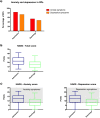Psychological effects of remote-only communication among reference persons of ICU patients during COVID-19 pandemic
- PMID: 33422153
- PMCID: PMC7794617
- DOI: 10.1186/s40560-020-00520-w
Psychological effects of remote-only communication among reference persons of ICU patients during COVID-19 pandemic
Abstract
Background: During COVID-19 pandemic, visits have been prohibited in most French ICUs. Psychological effects, for reference persons (RPs), of remote-only communication have been assessed.
Methods: All RPs of patients referred to ICU for COVID-19 were included. HADS, IES-R, and satisfaction were evaluated at admission, discharge/death, and 3 months. At 3 months, a psychologist provided a qualitative description of RPs' psychological distress.
Results: Eighty-eight RPs were included. Prevalence of anxiety and depression was 83% and 73% respectively. At 3 months, lower HADS decrease was associated with patient death/continued hospitalization, and/or sleeping disorders in RPs (p < 0.01). Ninety-nine percent RPs felt the patient was safe (9 [7; 10]/10 points, Likert-type scale), confident with caregivers (10 [9; 10]/10 points), and satisfied with information provided (10 [9; 10]/10 points). All RPs stressed the specific-type of "responsibility" associated with being an RP in a remote-only context, leading RPs to develop narrow diffusion strategies (67%) and restrict the array of contacted relatives to a very few and/or only contacting them rarely. 10 RPs (30%) related the situation to a prior traumatic experience.
Conclusion: RPs experienced psychological distress and reported that being an RP in a remote-only communication context was a specific responsibility and qualified it as an overall negative experience.
Trial registration: NCT04385121 . Registered 12 May 2020. https://clinicaltrials.gov/ .
Keywords: COVID-19; Reference person; Relative; Anxiety; Depression; Distress.
Conflict of interest statement
The authors declare that they have no competing interests.
Figures





References
-
- COVID-19 Dashboard by the Center for Systems Science and Engineering (CSSE) at Johns Hopkins University (JHU) - Coronvirus Ressource Center. https://coronavirus.jhu.edu/map.html.
-
- Davidson JE, Aslakson RA, Long AC, Puntillo KA, Kross EK, Hart J, et al. Guidelines for Family-Centered Care in the Neonatal, Pediatric, and Adult ICU. Crit Care Med. 2017;45(1):103–128. - PubMed
-
- Lautrette A, Darmon M, Megarbane B, Joly LM, Chevret S, Adrie C, et al. A communication strategy and brochure for relatives of patients dying in the ICU. New Engl J Med. 2007;356(5):469–478. - PubMed
-
- Davidson JE, Jones C, Bienvenu OJ. Family response to critical illness: postintensive care syndrome-family. Crit Care Med. 2012;40(2):618–624. - PubMed
Associated data
LinkOut - more resources
Full Text Sources
Other Literature Sources
Medical

